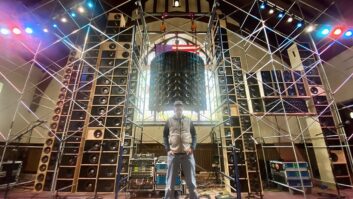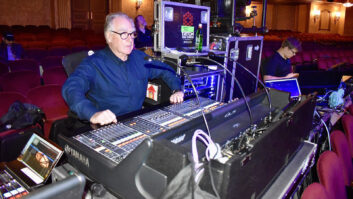New York, NY (March 15, 2019)—There are productions that try to beat up the audience with their audio systems; this is not one of them. Instead, Ultimate Fighting Championship (UFC) mixed martial arts events leave the brawling to the professionals in the Octagon, but the audio system they use still has plenty of brawn.
The principal architect behind the system is Daniel Bonneau, senior director of audio production for Bloomfield, CT-based ConCom, the production company that has provided both live AVL and broadcast production services throughout most of UFC’s existence. Bonneau has been the FOH engineer for nearly all UFC events over the past decade—easily more than 300, he surmises. At each event, he mixes everything, including inputs from Sennheiser digital wireless mics with Neumann KK205 capsules, along with wired Neumann KMS 105 mics, on a Yamaha CL-5 digital console, using a pair of Meyer Sound Amie studio monitors for nearfield reference. There’s more Meyer boxes around, however—while ConCom initially used a Meyer Sound Mica-based system for nearly seven years of UFC fights, in more recent times, it has traded up to a 120-box Meyer Leopard rig.
“The sonic quality immediately stepped up to a higher level,” Bonneau recalled, but other factors played into the decision to update, including being able to scale the system to different sized-arenas, and the ability to implement a fiber-optic AVB network for linking FOH to the Galileo Galaxy processors for the arrays. But as the arrays had to be flown high above the center scoreboard-mounted video screens, the question arose: Where to best place the array processors?
Bonneau’s solution was to build two custom steel pods, one flown on each side of the center scoreboard, and each serving three purposes. The top portion provides storage for the cable looms connected to the three Leopard arrays covering each end of the arena; the pod’s side incorporates racks for power distro along with two Luminex AVB network switches and four Galaxy processors; and the bottom provides rigging points that support two different configurations for the 1100-LFC low frequency control elements.
“It’s unbelievable how much quicker things are going now,” said Bonneau. “We’re saving over an hour on load-in and at least a half-hour on load out. If points are clear, we’re typically floating off the ground in three hours. The way we package the system, the array boxes are rolling on carts of four, with our side hangs 12 deep and end hangs 16 deep. So it’s click-click-click on three or four carts and you’re done.”
The system also incorporates a total of eight flown 1100-LFC elements, along with four 900-LFC elements tucked under the Octagon. Also directly underneath the Octagon mat are five Sennheiser 421 microphones that are routed directly to the 1100-LFC elements. “When a fighter gets picked up and thrown down, it lays your hair back when he hits the mat,” said Bonneau. “The fans may not be consciously aware of the effect but it intensifies the total experience.”
With a flown array trim height typically at 60 to 80 feet, a separate system is required for the floor seats. Eight UPA-1P loudspeakers are mounted to lighting fingers extending out from a lighting truss rigged over the Octagon. In addition, eight UPQ-1P loudspeakers are mounted on the main lighting truss. This configuration allows Bonneau to tailor a custom stereo mix for each of the four quadrants, with one high-impact mix for UFC executives seated at the Octagon and a boost in vocal clarity for the press section.
Bonneau is thrilled by the way the system has elevated the experience for fans in attendance despite the limitations of broadcast. “When we deployed this rig for the first event,” he recalled, “we knocked it out of the park.”
Meyer Sound • www.meyersound.com
ConCom • www.concom.tv






